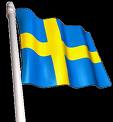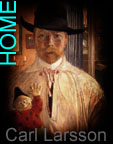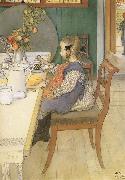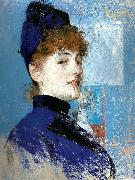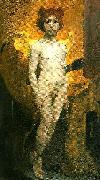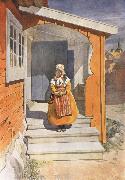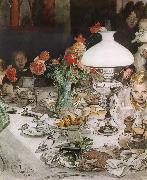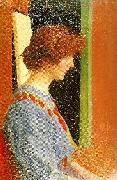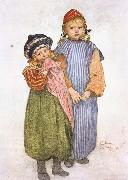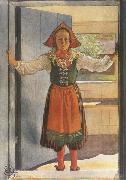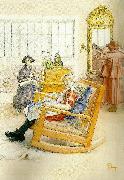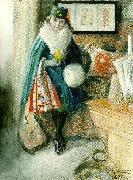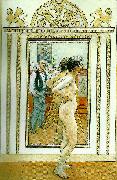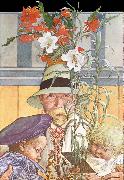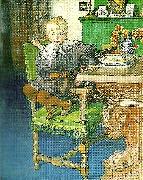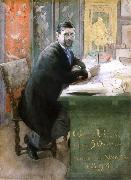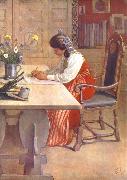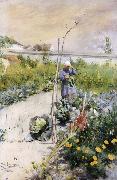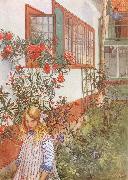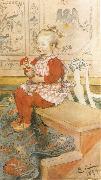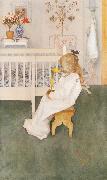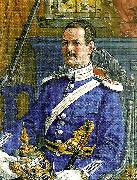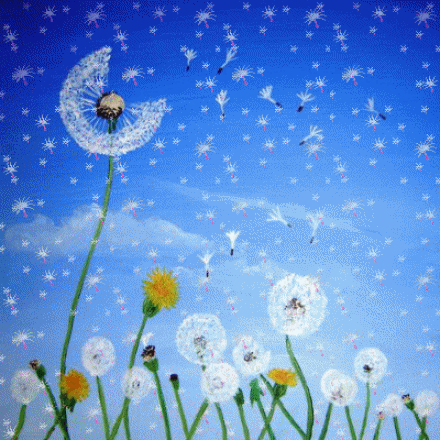|
|||||||||
Summer in Sweden - Welcome to visit our gallery in Sweden!
Carl Larsson - His Life and His Works
Carl Larsson (May 28, 1853–January 22, 1919) was a Swedish painter and interior designer, representative of the Arts and Crafts Movement. Larsson was born in Prästgatan No.78, a house on the Tyska Stallplan in Gamla stan, the old town in Stockholm. His parents were extremely poor and his childhood was not happy. Renate Puvogel, in her book Larsson, gives plenty of information about his life: "His mother was thrown out of the house, together with Carl and his brother Johan; after enduring a series of temporary dwellings, the family moved into Grev Magnigränd No.7 (later No.5) in what was then Ladugårdsplan, present-day Östermalm. As a rule, each room was home to three families; penury, filth and vice thrived there, leisurely seethed and smouldered, eaten-away and rotten bodies and souls. Such an environment is the natural breeding ground for cholera," he wrote in his autobiographical novel Me (Jag, Stockholm, 1931, p. 21). Carl's father was also a good-for-nothing who worked as a casual laborer, sailed as a stoker on a ship headed for Scandinavia, and lost the lease to a nearby mill, only to end up there later as a mere grain carrier. Larsson portrays him as a loveless man lacking self-control; he drank, ranted and raved, and incurred lifelong anger of his son through his outburst "I curse the day you were born." In contrast, Carl's endlessly working mother provided for their everyday needs through her job as a laundress.[1] Carl's artistic talent was probably inherited from his grandfather on his mother's side, who was a painter by trade. However, at the age of thirteen, his teacher Jacobsen, at the school for poor children urged him to apply to the "principskola" of the Royal Swedish Academy of Arts, and he was admitted. During his first years there, Larsson felt socially inferior, confused, and shy. In 1869, at the age of sixteen, he was promoted to the "antique school" of the same academy. There Larsson gained confidence, and even became a central figure in student life. Carl earned his first medal in nude drawing. In the meantime, Larsson worked as a caricaturist for the humorous paper Kasper and as graphic artist for the newspaper Ny Illustrerad Tidning. His annual wages were sufficient to allow him to help his parents out financially. Frukost under stora björken ("Breakfast under the big birch"), 1896. Christmas Eve (1904–1905)After several years working as an illustrator of books, magazines, and newspapers, Larsson moved to Paris in 1877, where he spent several frustrating years as a hardworking artist without any success. Larsson was not eager to establish contact with the French progressive impressionists; instead, along with other Swedish artists, he cut himself off from the radical movement of change. Karin Bergöö, Larsson's wifeAfter spending two summers in Barbizon, the refuge of the plein-air painters, he settled down with his Swedish painter colleagues in 1882 in Grez-sur-Loing, at a Scandinavian artists' colony outside Paris. It was there that he met the artist Karin Bergöö, who soon became his wife. This was to be a turning point in Larsson's life. In Grez, Larsson painted some of his most important works, now in watercolour and very different from the oil painting technique he had previously employed. Carl and Karin Larsson had eight children and his family became Larsson's favourite models. Many of his watercolours are now popular all over the world. Their eight children included Suzanne (1884), Ulf (1887, who died at 18), Pontus (1888), Lisbeth (1891), Brita (1893), Mats (1894, who died at 2 months), Kersti (1896) and Esbjörn (1900). In 1888 the young family was given a small house, named Little Hyttnäs, in Sundborn by Karin's father Adolf Bergöö. Carl and Karin decorated and furnished this house according to their particular artistic taste and also for the needs of the growing family. Through Larsson's paintings and books this house has become one of the most famous artist's homes in the world, transmitting the artistic taste of its creators and making it a major line in Swedish interior design. The descendants of Carl and Karin Larsson now own this house and keep it open for tourists each summer from May until October. Larsson's popularity increased considerably with the development of colour reproduction technology in the 1890s, when the Swedish publisher Bonnier published books written and illustrated by Larsson and containing full colour reproductions of his watercolours, e.g. A Home. However, the print runs of these rather expensive albums did not come close to that produced in 1909 by the German publisher Karl Robert Langewiesche (1874 –1931): His choice of watercolours, drawings and text by Carl Larsson, titled Das Haus in der Sonne (The House in the Sun), immediately became one of the German publishing industry's best-sellers of the year 40,000 copies sold in three months, and more than 40 print runs have been produced up to 2001. Carl and Karin Larsson declared themselves overwhelmed by such success. Larsson also drew several sequential picture stories, thus being one of the earliest Swedish comic creators.[citation needed] Carl Larsson considered his monumental works, such as his frescos in schools, museums and other public buildings, to be his most important works. His last monumental work, Midvinterblot (Midwinter Sacrifice), a 6x14 meter oil painting completed in 1915, had been commissioned for a wall in the National Museum in Stockholm (which already had several of his frescos adorning its walls), but was upon completion rejected by the board of the museum. The fresco depicts the blót of King Domalde at the Temple of Uppsala.
Copyright Reserved
|
|||||||||

